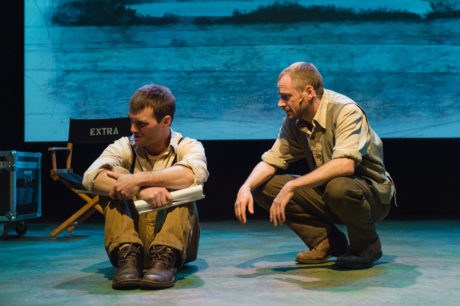Engaging with warm-hearted humor and disarming in the depth of scenes about lost boys and bitter men with their dreams crushed, the Keegan Theatre production of the Marie Jones’ Stones in his Pockets (1999) is a winner of a serious comedy.

Under the affectionate, perceptive direction of Abigail Isaac Fine, Stones in his Pockets aims for and succeeds at understanding; it’s not just “shtick” with over-the-top, camp characterizations. With adept acting prowess, Matthew J. Keenan and Josh Sticklin take on over a dozen idiosyncratic, quickly appearing, then smoothly disappearing, characters. Keenan and Sticklin give each of their characters their all – within the blink of an eye and without major costume changes, but through physical characterizations and voice inflections. The two actors can be Irish or American, man or woman, younger or old.
Characters portrayed by Keenan and Sticklin can show good cheer and sunny dispositions or display deep wisdom and pain. The two actors can be almost fey one moment, glamorous, or feeble the next. They can portray a model of manly rectitude one moment and be broken into emotional pieces a moment later. They can be models of the authentic, then completely artificial.
Stones in his Pockets is set in a scenic, rural area in contemporary Ireland. The area is not as prosperous as it once was; life is bleak for its citizens. A decent future seems out-of-reach. Even dairy farms with their herds of cattle are having a difficult time staying afloat without selling off land. A Hollywood movie company comes to the area to film a movie and hires local extras. The extras are able to earn 40 quid (about $53 US) a day and enjoy a free lunch with one dessert for just being themselves.

With few opportunities, the local folk (the have-nots) who have few economic options in life take the jobs. They find themselves surrounded by Brits and Americans (the haves) who seem to have the world dancing on their fingertips.
The two mid-thirties, down-on-their luck central characters are Charlie (Josh Sticklin), who had to close his video store – going into bankruptcy – along with Jake (Matthew J. Keenan), who has returned to Ireland from an unsuccessful stint living in America. He was trying to find the American Dream, but left with his hopes dashed.
As written by Irish playwright Jones, the American and English characters have a dismissive attitude toward the Irish “extras.” The non-Irish don’t have much interest in the local community, only its value as a setting for a film shoot. Then over time, and as Act II unfolds, the English and American characters show some heart as a tragedy occurs that they cannot simply dismiss.
Among the dozen characters is a glamorous “user” of others, yet needy movie star named Caroline Giovanni. There is also a third Assistant Director named Aisling, who only wants to impress her bosses, and an ambitious first Assistant Director named Simon, who gives the word “settle” a delightful gloss whenever the word is intoned to quiet down the extras.

An old man named Mickey shows his chops as he speaks of being a movie extra in the famous John Ford film, The Quiet Man (a real film from 1955). Also, critically, there is Sean – a local young man who, after being humiliated by the movie folk, becomes the sad secret for the title of the play, Stones in his Pockets – as well as his bereaved father, a local priest, and a best friend who believes himself a causal factor for the tragedy.
I do want to call attention to several scenes that were theatrically imaginative delights. These scenes are when Keenan and Sticklin are juxtaposed before a projection of them “acting;” they are sullen and ironic as the director asks for enthusiasm or jumping with joy. These scenes brought the house down with well-deserved, loud, knowing laughter.
Set Designer Matthew J. Keenan has made a simple set design using a couple of canvas folding chairs, a number of trunks, and a video camera on a tripod. With critical projection design by G. Ryan Smith (often of gouache looking scenes), lighting from Megan Thrift, and sound design by Dan Deiter, the play has all it needs. Add in Costume Designer Nitya Ramlogan’s roughed up, loose-fitting pants and shirts and some working-man caps, and the characters can be anyone at any time.
Stones in his Pockets could have easily gone after the laughter of stereotypes and unwarranted attention-seeking. But Director Fine did not pursue that thrust. Keegan’s production is an astute evening of theater that takes on a horrible event, surrounding itself with warm-hearted humor. Even better; those at the bottom focus on getting theirs before the top-dogs take it all.
Stones in his Pockets is a worthy production about life’s unfairness. It ultimately shows that resilience in the face of bad times might lead to ways to thrive.
Running time: One hour and 50 minutes, with one intermission.
Stones in his Pockets plays through October 15, 2017 at Keegan Theatre—1742 Church Street NW, in Washington, D.C. For tickets, call the box office at (202) 265-3767, or purchase them online.
NOTE: I left the theater wondering if there is play out there that speaks to similar rural poor vs rich urban dweller issues much closer to home. Perhaps changing the accents to those of say West Virginia or Arkansas, and having the tragedy connected to the scourge of opiate addiction.





